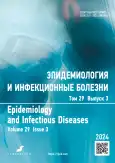Гиподиагностика ботулизма как причина трагедии: случай из практики
- Авторы: Никифоров В.В.1,2, Кожевникова А.В.1,3, Тюрин И.Н.3, Чернобровкина Т.Я.1, Зыкова О.А.1, Антипят Н.А.3, Ляпейкова Е.А.3
-
Учреждения:
- Российский национальный исследовательский медицинский университет имени Н.И. Пирогова
- Академия постдипломного образования Федерального научно-клинического центра специализированных видов медицинской помощи и медицинских технологий
- Инфекционная клиническая больница № 1
- Выпуск: Том 29, № 3 (2024)
- Страницы: 204-214
- Раздел: КЛИНИЧЕСКИЕ СЛУЧАИ
- URL: https://journal-vniispk.ru/1560-9529/article/view/265937
- DOI: https://doi.org/10.17816/EID632547
- ID: 265937
Цитировать
Аннотация
Ботулизм имеет свою, совершенно уникальную клиническую картину, однако некоторые его проявления, взятые по отдельности, сходны с проявлениями других, как инфекционных, так и неинфекционных, болезней. Это способствует возникновению диагностических ошибок, тем более что ботулизм не относится к числу часто встречающихся инфекционных заболеваний, ввиду чего основная масса практических врачей оказывается знакомой с клинической картиной ботулизма исключительно в теории и явно недостаточно. В статье даётся анализ течения ботулизма при групповом семейном заболевании, когда ни на одном этапе оказания медицинской помощи диагноз ботулизма при первичном обращении к специалистам ни у одного из заболевших диагностирован не был. Кроме того, обсуждаются причины и следствие длительной токсемии (20 дней) у одного из пациентов.
Полный текст
Открыть статью на сайте журналаОб авторах
Владимир Владимирович Никифоров
Российский национальный исследовательский медицинский университет имени Н.И. Пирогова; Академия постдипломного образования Федерального научно-клинического центра специализированных видов медицинской помощи и медицинских технологий
Автор, ответственный за переписку.
Email: v.v.nikiforov@gmail.com
ORCID iD: 0000-0002-2205-9674
SPIN-код: 9044-5289
д-р мед. наук, профессор
Россия, Москва; МоскваАнастасия Владимировна Кожевникова
Российский национальный исследовательский медицинский университет имени Н.И. Пирогова; Инфекционная клиническая больница № 1
Email: ice1234@yandex.ru
ORCID iD: 0009-0009-2606-7071
Россия, Москва; Москва
Игорь Николаевич Тюрин
Инфекционная клиническая больница № 1
Email: ikb@zdrav.mos.ru
ORCID iD: 0000-0002-5696-1586
SPIN-код: 6755-0576
канд. мед. наук, доцент
Россия, МоскваТатьяна Яковлевна Чернобровкина
Российский национальный исследовательский медицинский университет имени Н.И. Пирогова
Email: Tanyura541@mail.ru
ORCID iD: 0009-0008-3853-4792
канд. мед. наук, доцент
Россия, МоскваОльга Алексеевна Зыкова
Российский национальный исследовательский медицинский университет имени Н.И. Пирогова
Email: ozpenza@yandex.ru
ORCID iD: 0009-0004-6668-2144
SPIN-код: 3146-1468
канд. мед. наук, доцент
Россия, МоскваНаталья Александровна Антипят
Инфекционная клиническая больница № 1
Email: ikb@zdrav.mos.ru
ORCID iD: 0000-0001-8578-2838
Россия, Москва
Екатерина Александровна Ляпейкова
Инфекционная клиническая больница № 1
Email: ikb@zdrav.mos.ru
ORCID iD: 0000-0002-5071-6328
Россия, Москва
Список литературы
- Никифоров В.В. Ботулизм. Санкт-Петербург: Эко-Вектор, 2024. 528 с. EDN: NDPUMZ
- Chatham-Stephens K., Fleck-Derderian S., Johnson S.D., et al. Clinical Features of Foodborne and Wound Botulism: A Systematic Review of the Literature, 1932–2015 // Clin Infect Dis. 2017. Vol. 66, Suppl. 1. P. S11–S16. doi: 10.1093/cid/cix811
- Harvey R.R., Cooper R., Bennett S., et al. Outbreak of Foodborne Botulism in an Immigrant Community: Overcoming Delayed Disease Recognition, Ambiguous Epidemiologic Links, and Cultural Barriers to Identify the Cause // Clin Infect Dis. 2017. Vol. 66, Suppl. 1. P. S82–S84. doi: 10.1093/cid/cix817
- Rao A.K., Walters M., Hall J., et al. Outbreak of Botulism Due to Illicit Prison-Brewed Alcohol: Public Health Response to a Serious and Recurrent Problem // Clin Infect Dis. 2017. Vol. 66, Suppl. 1. P. S85–S91. doi: 10.1093/cid/cix936
- St Louis M.E., Peck S.H., Bowering D., et al. Botulism from chopped garlic: delayed recognition of a major outbreak // Ann Intern Med. 1988. Vol. 108, N 3. P. 363–368. doi: 10.7326/0003-4819-108-3-363
- Rao A.K., Lin N.H., Griese S.E., et al. Clinical Criteria to Trigger Suspicion for Botulism: An Evidence-Based Tool to Facilitate Timely Recognition of Suspected Cases During Sporadic Events and Outbreaks // Clin Infect Dis. 2017. Vol. 66, Suppl. 1. P. S38–S42. doi: 10.1093/cid/cix814
- Hughes J.M., Blumenthal J.R., Merson M.H., et al. Clinical features of types A and B food-borne botulism // Ann Intern Med. 1981. Vol. 95, N 4. P. 442–445. doi: 10.7326/0003-4819-95-4-442
- Badell M.L., Rimawi B.H., Rao A.K., et al. Botulism During Pregnancy and the Postpartum Period: A Systematic Review // Clin Infect Dis. 2017. Vol. 66, Suppl. 1. P. S30–S37. doi: 10.1093/cid/cix813
- Griese S.E., Kisselburgh H.M., Bartenfeld M.T., et al. Pediatric Botulism and Use of Equine Botulinum Antitoxin in Children: A Systematic Review // Clin Infect Dis. 2017. Vol. 66, Suppl. 1. P. S17–S29. doi: 10.1093/cid/cix812
- Sheth A.N., Wiersma P., Atrubin D., et al. International outbreak of severe botulism with prolonged toxemia caused by commercial carrot juice // Clin Infect Dis. 2008. Vol. 47, N 10. P. 1245–1251. doi: 10.1086/592574
- Centers for Disease Control and Prevention (CDC). Botulism Annual Summary, 2018. Atlanta: U.S. Department of Health and Human Services, CDC, 2021.
- Rao A.K., Sobel J., Chatham-Stephens K., Luquez C. Clinical Guidelines for Diagnosis and Treatment of Botulism, 2021 // MMWR Recomm Rep. 2021. Vol. 70, N 2. P. 1–30. doi: 10.15585/mmwr.rr7002a1
Дополнительные файлы







